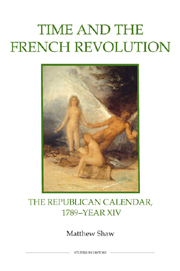Book contents
- Frontmatter
- Contents
- List of illustrations
- Preface
- Miscellaneous Frontmatter
- Acknowledgements
- Abbreviations
- Introduction: writing the history of the republican calendar
- 1 Time and history
- 2 The French republican calendar, 1793–1806: a narrative account
- 3 Cultivating the calendar: the calendar and republican culture in the Year II
- 4 The clash with religion
- 5 Work and rest
- 6 Republican hours
- Conclusion: the legacy of the republican calendar
- APPENDICES
- 1 Timeline of key events, 1788–1806
- 2 The republican calendar: a glossary
- 3 Names of the days of the republican year
- 4 Concordance for the Gregorian and republican calendars
- Bibliography
- Index
1 - Time and history
Published online by Cambridge University Press: 12 September 2012
- Frontmatter
- Contents
- List of illustrations
- Preface
- Miscellaneous Frontmatter
- Acknowledgements
- Abbreviations
- Introduction: writing the history of the republican calendar
- 1 Time and history
- 2 The French republican calendar, 1793–1806: a narrative account
- 3 Cultivating the calendar: the calendar and republican culture in the Year II
- 4 The clash with religion
- 5 Work and rest
- 6 Republican hours
- Conclusion: the legacy of the republican calendar
- APPENDICES
- 1 Timeline of key events, 1788–1806
- 2 The republican calendar: a glossary
- 3 Names of the days of the republican year
- 4 Concordance for the Gregorian and republican calendars
- Bibliography
- Index
Summary
The varieties of temporal experience
Time is an elusive category. On the one hand, as the literary critic Stuart Sherman has noted, the eighteenth century was marked by ‘its unprecedented passion for chronometric exactitude, in its timepieces and in its prose’. Time could be understood as a metaphor for regularity, order and control, with a Supreme Being setting the world in motion like clockwork. Montesquieu, for example, privileged the machinery of clockwork as a simile in the 1757 foreword to his L'Esprit des loix: ‘the spring that makes republican government move, as honor is the spring that makes monarchy move’. Yet, as Michèle Perrot suggests, time could also be ‘extendable, elastic, fluid according to the light, lengthened or shortened following the seasons, the time of the sun, nonchalant and dreamy’. Crudely put, time in the eighteenth century can be depicted as either ‘baroque’, pre-industrial, dominated by the seasons, the sun and the irregular routines of farming, the small workshop and the patterns of the Catholic year, or as a period of transition towards what E. P. Thompson has termed ‘industrial work time’, albeit perhaps less to do with factories and industrialisation than linked to the aesthetic order of neo-classicism, the obsession with horology shown in the Encyclopédie and a desire to control and regulate on behalf of society's elite.
- Type
- Chapter
- Information
- Time and the French RevolutionThe Republican Calendar, 1789-Year XIV, pp. 17 - 28Publisher: Boydell & BrewerPrint publication year: 2011



